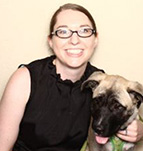We can’t help it if we love our dogs so much. There are very scientific reasons for this social bond: Dogs physiologically win over our hearts by causing our brains to release the chemicals responsible for feel-good emotions. Dr. Hare explores the importance of love and what it means for our relationship with dogs, and, most importantly, how they are one of the only animals on Earth to tap into this.

Senior Scientist in the Behavior Group at Nestle Research and Development Center.

Director of the Kinsey Institute at Indiana University in Bloomington, where she studies, among other subjects, social bonding.

PhD student at the Cognitive Neuroscience Research Unit at City University London, where he conducted the first study on contagious yawning across species.

Assistant Professor at the School of Anthropology at the University of Arizona.
Brian Hare: “DogSmarts” is brought to you by Purina Pro Plan Bright Mind—a breakthrough in pet nutrition created to nourish a dog’s mind. Is your dog’s food feeding your dog’s brain? Discover more at BrightMindEffect.com.
Canines and humans are not just connected by companionship. In fact, we are evolutionarily linked. We’re tied together by something far more complex—our brains.
Join me as we take a peek into the inner workings of the canine brain through the lens of human cognition. With a mix of stories and interviews from leading psychologists, anthropologists, veterinarians, and dog owners, we’re going to tackle questions of memory, word learning, nutrition, and even love.
I’m Brian Hare, Founder of Dognition, and Professor at Duke University in Cognititive Neuroscience.
Welcome to Dog Smarts”.
BH: Hi I’m (yawns), oh excuse me. I’m Brian (yawn). Wow, I must not have slept. So, just curious. How many of you out there just yawned or feel like yawning now? So, the reason you might have yawned or felt like yawning is something called emotional contagion, which is a basic form of empathy, or feeling what someone else is feeling. When you see someone, hear someone or even read about someone yawning, you can feel this almost uncontrollable urge to yawn in response. It’s because empathy is about catching someone’s emotion. That’s why yawning is an example of emotional contagion. Today I’m speaking with guest who can tell us a little more about this and what it means for our relationship with your dog.
Ramiro Joly¬Mascheroni, a Ph.D student at the Cognitive Neuroscience Research Unit at City University London. He figured out that dogs contagiously yawn and I wanted to hear more him about how he figured that out!
Ramiro JolyMascheroni: It was by chance actually. I wanted to explore a bit further the literature and while reading, the only study at the time that was done on contagious yawning in animals, which was a within species study among chimpanzees, I had my dog, sat next to me. So, I was finding this lit very interesting and I looked at my dog, and I yawned in front of her, and she yawned immediately¬¬ almost instantaneously.
BH: Wow. And what's her name?
RJM: Her name was Brenda.
BH: Awesome. And then what did you do?
RJM: Well, what I found interesting was that Brenda, when she perceived, visually perceived me yawning, she turned her face and looked away and then immediately yawned back. So I was wondering whether the same happened with other dogs. I found similar reactions in other dogs, too. This looking away, almost as if they were picking up a message. And I found that interesting, and in fact, it kind of showed in the result when I could see that most of the working breeds, which tend to be more attentive, they look at you more and they make a bit more eye contact than perhaps non¬working breeds. By being attentive, they might be picking up the signal that I was wondering was being transferred at the time, a signal.
BH: Very cool. So let me ask you¬¬ so there is Brenda, sitting by you, yawning. Now, don't be a scientist for a minute, just be a dog owner, a dog lover. How did that make you feel about your dog?
RJM: I t made me feel even closer. It made me feel that the dog was understanding what I was feeling at the time. It made me feel a stronger connection with my dog.
BH: We’ll be back with more DogSmarts... I’m Brian Hare.
“DogSmarts” is brought to you by Purina Pro Plan Bright Mind—the result of years of research into the positive impact nutrition can have on a dog’s cognitive health. For dogs seven and older, there’s Bright Mind Adult 7P lus, with enhanced botanical oils shown to promote alertness and mental sharpness in dogs seven and older, with visible results within 30 days, helping them think more like they did when they were younger. For adult dogs, there’s Bright Mind Adult, featuring a proprietary blend of brain supporting nutrients. When fed daily, the blend of nutrients in Bright Mind Adult helps support a dog’s cognitive health throughout adulthood—to help him reach his full potential. Available exclusively at Pet Specialty Retailers such as Petsmart, Petco and Pet Supplies Plus. Purina Pro Plan Bright Mind Adult and Adult 7 Plus. Is your dog’s food feeding your dog’s brain? Discover more at BrightMindEffect.com.
Welcome back to DogSmarts. I’m Brian Hare.
BH: We can’t help it if we love our dogs so much. There are very real, very scientific reasons for this social bond. Dogs have found a way to physiologically win over our hearts by causing our brains to release the chemicals responsible for feel-good emotions. How are they one of the only animals on Earth to tap into this? One of the world’s experts on a particular little chemical called oxytocin is going to explain.
Sue Carter: My name is Sue Carter I am director of the Kinsey Institute at Indiana University in Bloomington.
BH: Tell us, what is oxytocin?
SC: Well, oxytocin is a very simple molecule. It has 9 amino acids, it's found in all mammals, or something close to oxytocin is found in all mammals, or something close to it is found in all mammals. So oxytocin promotes social behavior in general in all of the mammals that thus far have been studied, from humans down to very simple rodents. I look upon oxytocin as a kind of insurance policy that guarantees and times this maternal behavior so that it's always going to turn up at exactly the time the baby does.
BH: If oxytocin is a facilitator of social bonding – how is it involved in other areas of our lives?
SC: So much of what happens to us in life is not rational. This big cortex that’s allowing you and me to have a conversation, is constantly trying to make sense of life's experiences, but many of them are wired into these ancient parts of the brain that are not very sensible.
BH: They are certainly not sensible. And one of the least sensible relationships we have, some would argue, are those we have with our dogs. For me, I adore my dog Tassie, he’s totally special to me, but I do have to wonder sometimes when I am scooping his poop or taking him for walks, cleaning his dog bed, worrying about what toy he may or may not like, brushing his hair, shampooing it so he looks good – who really is getting the better end of the deal? So, I want to talk now to someone who says dogs have hijacked our oxytocin bonding pathway.
Evan McLean: The evidence is exactly this phenomenon that dogs can elicit the same kind of response in people.
BH: That’s Evan McLean an Assistant Professor in the School of Anthropology at the University of Arizona.
EM: So dogs can cause people to have this oxytocin response that we have when we're dealing with romantic partners or when we're interacting with our children, and so evolutionarily there's no way that oxytocin was supposed to originally serve this role. This is not something that evolved to help humans dogs have a special bond together. It's something that's really much more responsible for bonds within a species, but this is a situation where dogs have essentially found a way to physiologically win our hearts by causing us to have this kind of oxytocin release that triggers all these rewards systems in the brain, triggers emotions that feel good and dogs found a way to tap into this that other animals haven't.
BH: So it's not our fault we love our dogs so much.
EM: It's their fault and probably partially oxytocin's fault, too.
BH: So that's why they've been such a winner as a species, I guess.
EM: I’m mean one of the really interesting things here is it's not just the presence of dogs that causes these effects, it's not that we see a furry dog and suddenly we have a big release of oxytocin, that's all dogs have to do. There are actually specific behaviors that cause this to happen. And one of this big ones is…
BH: So what are they?
EM: Well eye contact is one of the big ones.
BH: So I make a lot of eye contact with my dog, this is causing oxytocin to be released in the dog? Or?
EM: In actually both you and the dog.
BH: Wait, both of us?
EM: In both of you. That's right that's right. So there's a very nice study looking at naturalistic interactions between people and their dogs. And what they find is that you can essentially divide the dog¬-human dyads into two different clusters and there are groups that shared a lot of eye contact and groups that shared very little contact.
BH: Mhm.
EM: And what you find in this situation is that it's only in these dog¬-human pairs where there’s a lot of eye contact that you see this oxytocin release in both partners.
BH: Wow, okay so are you saying that dogs hug us with their eyes?
EM: That might be the dog equivalent of the hug yeah I think that's a nice analogy.
BH: So seriously, it’s not our fault we love our dogs so much. To get a better understanding of how a canine brain works, though, we’ve GOT to go back a little bit and understand how a human brain works, too. Ragan McGowan, a Senior Scientist in the Behavior Group at Nestle Purina Research and Development Center explains a study she did with dogs called the Strange Situation Test and why we study attachment in dogs…
Ragan McGowan: When we're thinking about dogs that's usually the attachment style that people are looking for to say you know this dog is really attached to this person, and they're having that kind of emotional tie with them. A secure individual is one that uses the attachment figure, so whether it's the mother or the owner in the room as a secure base and then they'll explore the room and continue to check back in with that individual and explore the room. They'll voluntarily move away from them and then come back to them. and usually if they're separated and they come back in that reunion state that reunion is very smooth and they're immediately comforted by that individual and then we can say that they're securely attached to them.
BH: Now I am most interested you said that dogs that you have worked with and done the dog version of this test with are typically securely attached and I could imagine there are avoidant dogs. That I could imagine. But what about that middle group? The one when you come back together they’re not happy with you. Does that exist? Have you seen that?
RM: I haven't personally seen that in our studies but anecdotally you hear people talking about that all the time like oh my dog was really stressed when I left but I came back in and they were just like oh you're back okay and they went about their business.
BH: Like whatever, whatever you left me.
RM: Versus the dog that's running to the door to greet you and very excited that you’re back and actually seeking that contact with you. So I think it does exist.
BH: Given all your work trying to improve the lives of animals around us, what advice do you have for dog owners, what do you think, based on what you know about the emotional connection between people and dogs, what can people at home do?
RM: The biggest thing is to carve out time in your busy life to spend one on one with your dog. Even if you just have short times of the day to spend cuddling with them, if you can go outside to play games with them, if you can stimulate them mentally and physically then you're building a better relationship with the two of you and you're putting your dog in a really positive state.
Many thanks to Ragen McGowan, a Senior Scientist in the “Behavior Group" at Nestle Purina Research and Development Center; Sue Carter, Director of the Kinsey Institute at Indiana University in Bloomington, and Ramiro Joly¬-Mascheroni, a Ph.D student at the Cognitive Neuroscience Research Unit at City University London, and Evan MacLean, an Assistant Professor in School of Anthropology at the University of Arizona.
‘Dog Smarts’ is produced by Panoply Custom Studios, and is sponsored by Purina Pro Plan Bright Mind—a breakthrough in pet nutrition created to nourish a dog’s mind. Discover more at BrightMindEffect.com.